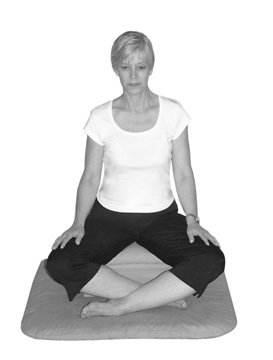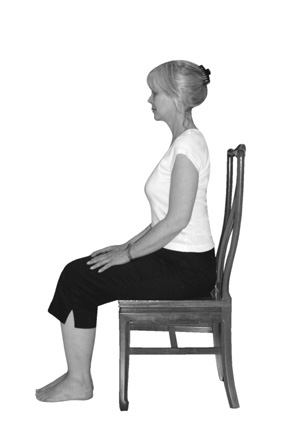Instructions for mindfulness-awareness or sitting meditation
 Sitting meditation is a friendly gesture towards ourselves where we take time to simply be and the mindfulness developed in the practice naturally unfolds on the job guiding us to Be Authentic, precise and decent. Sitting down and being still is at the heart of being awake at work. Yet, such meditation can not be rushed or forced, so we need not hurry; we can be flexible with ourselves and our life circumstances as we learn this practice.
Sitting meditation is a friendly gesture towards ourselves where we take time to simply be and the mindfulness developed in the practice naturally unfolds on the job guiding us to Be Authentic, precise and decent. Sitting down and being still is at the heart of being awake at work. Yet, such meditation can not be rushed or forced, so we need not hurry; we can be flexible with ourselves and our life circumstances as we learn this practice.
Posture
Second, we also notice that we are thinking: talking to ourselves, commenting on this and that, thinking about any number of things. Particularly if we are sitting for the first time, we may find ourselves unusually restless with our thoughts. Such restlessness is not a problem; it is what we work with in sitting.
 Attending to these two experiences - being alert in the immediate moment and thinking - is central to sitting practice and working with them properly requires a precise yet gentle awareness of the breath. The next instruction for sitting meditation, then, is when you notice yourself thinking, label your thinking by silently saying "thinking" and then bring your attention gently to your out-breath. You, in effect, label the thought "thinking" and bring your attention back to now.
Attending to these two experiences - being alert in the immediate moment and thinking - is central to sitting practice and working with them properly requires a precise yet gentle awareness of the breath. The next instruction for sitting meditation, then, is when you notice yourself thinking, label your thinking by silently saying "thinking" and then bring your attention gently to your out-breath. You, in effect, label the thought "thinking" and bring your attention back to now.
Attending to the breath
Attending to the out-breath in such a way requires patience and vigilance. Particularly at the beginning we may find our minds wandering and thinking and rarely attending to our out-breath. By patiently doing the practice, however, the mind begins to rest. In fact, it actually rests with the out-breath and we find that we can keep our attention on our out-breath like gently running our hand over a piece of silk. Slowly, precisely again and again we gently place our attention on our out-breath and eventually we find balance where we are mindful both of our breath in the immediate moment.
General remarks
 The meditation instruction presented here is called mindfulness-awareness or sitting meditation and it comes from the Tibetan Buddhist tradition. This instruction is enough to get started and it could even be all you'll ever need. But most likely this will not be the case. As you go further into a daily meditation practice, questions and obstacles will arise, which is quite natural. Traditionally, it is recommended that meditators receive face-to-face instructions from another person qualified to teach mindfulness-awareness meditation. This way you can appreciate the instruction, examine what is expected and ask questions. If you would like to receive individual meditation instruction please contact us.
The meditation instruction presented here is called mindfulness-awareness or sitting meditation and it comes from the Tibetan Buddhist tradition. This instruction is enough to get started and it could even be all you'll ever need. But most likely this will not be the case. As you go further into a daily meditation practice, questions and obstacles will arise, which is quite natural. Traditionally, it is recommended that meditators receive face-to-face instructions from another person qualified to teach mindfulness-awareness meditation. This way you can appreciate the instruction, examine what is expected and ask questions. If you would like to receive individual meditation instruction please contact us.
Generally, you will want to cultivate a regular sitting practice keeping to a schedule each day. At first, 15 minutes in the morning or evening will be ample time, but gradually, you will want to extend your practice, sitting 30, 40 or perhaps 60 minutes a day. But it's important to begin where you can, not to force yourself. You can extend the time of your sitting period naturally rather than feeling pushed or obliged. It is recommended that you set aside an area to meditate, uncluttered and free from distractions. Choosing to buy a meditation cushion and other accessories is fine, but sitting on a chair or stool is fine as well.
 The instructions given here are deceptively simple, so I encourage you to take your time and work with them gradually and wholeheartedly.
The instructions given here are deceptively simple, so I encourage you to take your time and work with them gradually and wholeheartedly.

